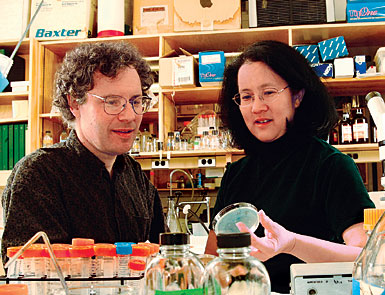DMS geneticists win prize for best paper in Science
Don't tell those who celebrate the Chinese New Year, but 2003 might be the year of the worm and not the year of the sheep— at least at Dartmouth Medical School. For their breakthrough discovery of micro-sized RNAs (miRNAs) in the worm C. elegans, two Dartmouth geneticists have earned the prestigious Newcomb Cleveland Prize and proven that the worm offers more insight into cell biology than had been thought.
Each year, the American Association for the Advancement of Science (AAAS) bestows the Cleveland Prize for the most significant paper published in the journal Science. This year's recipients, for an article titled "An Extensive Class of Small RNAs in Caenorhabditis elegans," included Victor Ambros, Ph.D., a professor of genetics at DMS, and Rosalind Lee, a research assistant. Ambros and Lee, who are married to each other, shared the award with two other research teams that also worked on miRNAs.
Convergence: "We converged on the discovery at the same time," Ambros says of the three teams' efforts. "Taken together, these three papers show that there exists a class of regulatory molecules originally thought to have only two members in nematodes. But they were found to exist everywhere. There is a lot of potential importance of this molecule to diverse biological processes. It is this potential that gets people excited."

|
|
Victor Ambros (left) and Rosalind Lee (right), members of the Department of Genetics
at Dartmouth, recently won the Newcomb Cleveland Prize, which is awarded
to the authors of the most significant paper published in the journal Science. |
Although Ambros and Lee first discovered miRNAs over a decade ago in the worm's lin-4 gene, they were puzzled for years about whether their discovery represented an isolated phenomenon. Ambros admits that they experienced a "low point" in their research when they felt they might be learning about a tiny part of worm development that held no broader implications for the study of genetics.
They became encouraged in 2000 when a lab at Massachusetts General Hospital discovered another miRNA with a different function in a different gene sequence. Since then, the research teams collectively have realized that miRNAs exist not only in worms, but also in other animals, including fruit flies, mice, and humans. Ambros is especially intrigued by the presence of miRNAs in human tissue and the role they might play in heart development.
Collaboration: The collaboration that facilitated the discovery of miRNAs will undoubtedly influence the direction of future research. Although Lee admits to now feeling more pressure to conduct further experiments and publish quickly, she is particularly proud of their role in validating other emerging research on the subject.
"People have worked for years on genes in several other species with clear phenotypes but were unable to clone them," she explains. "It has been very exciting to hear from them that they determined that their genes were miRNAs after they saw the papers. It has opened a door that nobody noticed was there."
Ambros, too, has been encouraged that years of research have resulted in a significant scientific breakthrough. Although he has experienced moments when he "rethought" his perspective and faith in his experiments, he says he felt a rewarding "sense of amazement" with the miRNA success.
At the same time that Ambros was enjoying this climax in his research career, he was also watching teenagers beginning their journey down the path of scientific discovery.
Expertise: Selected as a judge in the AAAS's Siemens-Westinghouse Competition in Math, Science, and Technology, the most prestigious national science and mathematics competition for high school students, Ambros offered his expertise in genetics to students presenting projects on that topic. Not only did judging the competition help Ambros remember how much he had loved science while he was growing up, but it also made him particularly appreciate earning the Cleveland Prize.
"Those kids really achieved something extraordinary relative to where they are in their education. . . . We are fully educated, trained, and well funded, and we just happened to make an interesting discovery," Ambros reflects. "There was luck in what we did, whereas those kids are doing really high-level science research coming from a highschool environment, not a research environment."
Future: "It's great to think about the future they have ahead of them," he says.
If you would like to offer any feedback about this article, we would welcome getting your comments at DartMed@Dartmouth.edu.
